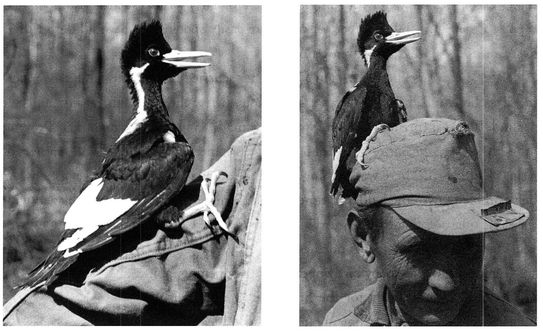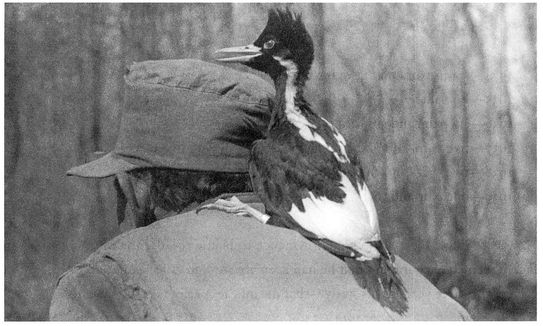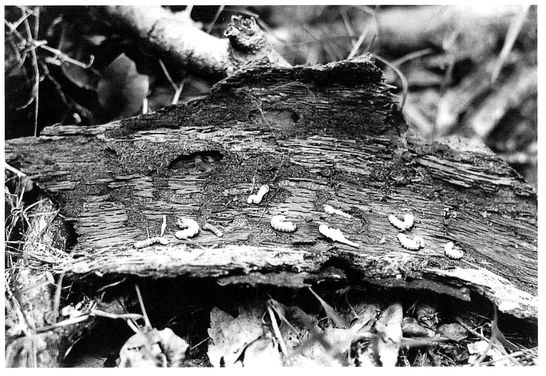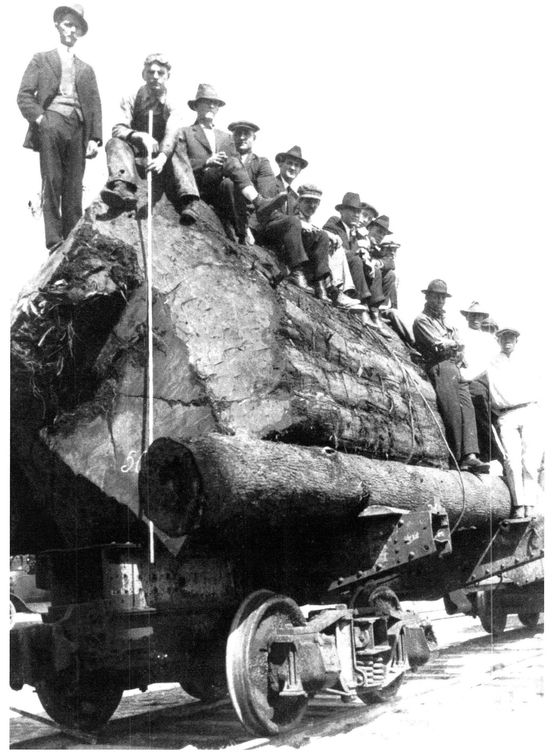The Race to Save the Lord God Bird (12 page)
Read The Race to Save the Lord God Bird Online
Authors: Phillip Hoose

The two men's deepening friendship was rooted in a respect for the forest. Jim Tanner and J. J. Kuhn were after something different from the game pursued by the hunters who had passed through the forest before them. Unarmed, and with their minds and hearts wide open, they were hunting for knowledge.
SONNY BOY
As Christmas of 1937 approached, Tanner and Kuhn set out to count all the Ivorybills in the Singer Tract. It was too early in the season for nests, but the birds were easy to see and hear in the leafless forest.
Quickly they found three pairs and another female who had no mate. That made seven birdsâa good start. But for some reason they couldn't find the young bird they had seen the spring before. Then, on December 22, rain began to fall, drumming steadily on their cabin roof for more than a week. The water collected in puddles in front of the cabin; then the puddles gathered into ponds. When the ponds merged into a sheet of water that made hiking impossible, Tanner drove back to New York for the holidays.
It was mid-February before he could return, and now there was no time to lose. Nesting season lasted from January to May, so there might already be young birds in the forest. Early on February 17 Tanner discovered a pair of Ivory-bills nesting in a live red maple tree at John's Bayou, not far from where he had observed the small family the year before. He built a blind and settled in to observe. More than anything, he wanted to know how many baby birds there were, but it might take weeks before nestlings were strong enough to appear at the hole. With the whole forest to cover, he didn't have that much time. He took a chance. On the morning of February 24, when both parents had flown away, Tanner hastily drove a ladder of spikes up toward the nest hole. He was about halfway to the nest when the adults flew back and caught him red-handed.
They dug their claws into a nearby tree and glared back over their shoulders at the huge invader. Then the male flew to the nest tree and hitched down the trunk toward Tanner, backing him down the spikes until he hopped onto the ground and stepped away. The male flew off but soon returned with a grub in its bill, disappearing
into the nest. Tanner let out a sigh of relief, for early writers such as Audubon had reported that Ivory-billed Woodpeckers were easily spooked and would desert their nests for even the slightest of reasons.
into the nest. Tanner let out a sigh of relief, for early writers such as Audubon had reported that Ivory-billed Woodpeckers were easily spooked and would desert their nests for even the slightest of reasons.
Later the parents flew off again and Tanner scurried back up his ladder, completing it as he climbed. When he got to the hole, he reached his hand inside and felt around. It was surprisingly warm. Something made “a long, scraping buzz.” Probing gingerly around the entire nest, Tanner's fingers came to rest upon the soft feathers of a single little bird. There was nothing else inside at all, not even pieces of eggshells. As he scrambled down the ladder in time to beat the parents, Tanner's mind blazed with the same question that had plagued him ever since the Cornell sound expedition three years before. Once again, only one nestlingâ
why
?
why
?
Ten days later, the baby bird appeared at the opening, poking its head out curiously for the first time. It was clearly a male. Soon he would be strong enough to fly and leave home. Tanner decided to try to “band” him with a lightweight collar around one foot so that researchers would be able to identify him anywhere he went and track his movements.
On March 6, banding day, Tanner and Kuhn waited at the nest tree for the adults to take their usual morning break. When they did, Tanner raced up the spike ladder. But as he drew near, the young bird poked his head out of the opening, spread his wings, and flung himself into the air. Tanner reached out instinctively and caught him. The bird struggled and squawked, but Tanner managed to fasten the band around one leg and gently place the young bird back in the cavity. However, their acquaintance was far from over. As Tanner lingered by the hole to whittle away a small branch that had blocked his view of the entrance, the young bird appeared again and took a second leap, this time plunging down past Tanner's grasp.
BANDING BIRDS
John James Audubon was the first person to “band” a bird. In 1803 he tied silver threads to the feet of Eastern Phoebes in Pennsylvaniaâbirds that migrate south in the winter. The next year, some of them returned to the same place to nest.
German scientists banded gulls and other birds that flew over the Baltic Sea in 1903. People who found these birds in France had no idea what the bands meant. They thought maybe the bands had been attached by sailors aboard a sinking ship.
Today the U.S. Fish and Wildlife Service issues people permits to fasten lightweight bands to the legs of birds. Each band is colored and has a specific number. The data tell us about the birds' migration routes and traveling speed, and how old they are. Jim Tanner is the only person ever known to have banded an Ivory-billed Woodpecker.
The bird fluttered into a tangle of vines, where he lay yelping and squawking. Tanner scrambled down the ladder and pulled him out of the thicket. He was, Tanner
wrote, “yelling loud enough to be heard in Tallulah.” Gently handing the bird to Kuhn, Tanner fumbled for his camera and started snapping pictures before the parents got back. He had already wasted six shots before he realized he hadn't focused the camera. He jammed more film in the camera and was firing away again when he realized he hadn't even opened the lens. He had rarely been this flustered in his life. He took a deep breath and made himself slowly go over how to operate a camera.
wrote, “yelling loud enough to be heard in Tallulah.” Gently handing the bird to Kuhn, Tanner fumbled for his camera and started snapping pictures before the parents got back. He had already wasted six shots before he realized he hadn't focused the camera. He jammed more film in the camera and was firing away again when he realized he hadn't even opened the lens. He had rarely been this flustered in his life. He took a deep breath and made himself slowly go over how to operate a camera.
Sonny Boy meets J. J. Kuhn

By this time, the young Ivory-bill had taken over the situation. No longer wailing, he climbed out of Kuhn's cupped hands and hopped sideways onto his wrist, perching on it as if it were a limb. Then he hitched his way up along Kuhn's arm and perched on his shoulder as Tanner snapped photos. Seeking the safety of a high perch, the bird continued up Kuhn's collar, scaled his head, and hopped atop his cap, puffing up his feathers to make himself look bigger. When Kuhn reached for the bird with his hand, the bird pecked at it, puncturing the skin. Tanner later wrote, “Though only a nestling, it had the imposing and elegant appearance of the Ivorybill and the quick and confident actions.”
When Tanner ran out of film, he wrapped the bird loosely in two soft handkerchiefs, buttoned him inside his shirt, and climbed back up the tree, placing him gently in the nest. This time the young bird stayed inside. As Kuhn and Tanner watched in hiding, the mother returned. To their relief, she fed her son without hesitation. The
father flew in a bit later with his own billful of grubs. “Sonny Boy,” as Tanner and Kuhn called the little bird, became history's only known banded Ivory-billed Woodpecker, and the only young Ivory-bill ever captured close-up on film.
father flew in a bit later with his own billful of grubs. “Sonny Boy,” as Tanner and Kuhn called the little bird, became history's only known banded Ivory-billed Woodpecker, and the only young Ivory-bill ever captured close-up on film.

THE FATAL FLAW
Seventeen months later, in October of 1939, Jim Tanner straightened his tie, cleared his throat, and faced the members and staff of the National Association of Audubon Societies in New York City. It was the third and final year he would deliver a report about his Audubon Research Fellowship on the Ivory-billed Woodpecker, and this time he illustrated his presentation with a slide show. The first slide showed his beloved carâas trusty a companion as any cowboy's horse.
Tanner showed slides of Kuhn, of “Sonny Boy,” of adult Ivory-bills, of towering trees and moonlit lakes, and then he got down to his conclusions. He estimated that there might still be about twenty-five Ivory-billed Woodpeckers left on earth, scattered throughout four or five large areas in Florida, Louisiana, and South Carolinaâthough he had seen the birds only in the Singer Tract in Louisiana.
He reported fewer and fewer Ivory-bills every year at the Singer forest. The numbers were as follows:
1934âseven pairs that gave birth to four birds
1935âno data
1936âsix pairs and six young birds
1937âfive pairs and one unmated adult, producing two young birds
1938âtwo pairs and three unmated adults; three young birds
1939âone pair and three unmated adults; one young bird
1935âno data
1936âsix pairs and six young birds
1937âfive pairs and one unmated adult, producing two young birds
1938âtwo pairs and three unmated adults; three young birds
1939âone pair and three unmated adults; one young bird
He didn't think there was enough evidence to blame the decline on inbreeding. In fact, it seemed encouraging that he had been able to find at least one successful nest in each of the three years of his studyâthat meant the species was still able to reproduce.
No, there was a much more serious problem, getting bigger each day. The birds were starving to death. The Chicago Mill and Lumber Company's giant band saw in Tallulah was devouring the last nesting, roosting, and food trees of the Lord God bird as fast as logs could be fed in. Time was running out fast for the Ivory-bill.
Tanner had finally identified the Ivory-bill's fatal flaw, at least at the Singer Tract. These birds needed a forest home big enough so that somewhere a few old trees were always dying natural deaths at any given time. These could be trees that were injured by lightning or wind or weakened by disease or old age, but they had to be still standing as they died. Only in such trees did the beetle larvae called grubs bore into still-tight bark to lay their eggs. Those grubs were almost the only thing that Ivory-billed Woodpeckers ate.
Why didn't these birds just change their diet and eat other things? What possible advantage was there to being such finicky eaters? Some birds, like Mourning Doves, draw nourishment from hundreds of plant species, and others eat many kinds of insects, as well as other prey. Tanner's theory was this: there were so many big, fat grubs under the bark of a tree just after it died that the Ivory-bills had formed a habit of looking for those trees and very little else. Large birds like Ivory-bills need a lot of food, especially when they are raising a young family, and the banquet under the bark could feed the Ivory-bills' families for a long time. Of all the woodpeckers, only the
Ivory-bill was strong enough to pry off bark while it was still bound tightly to the tree. Others had to wait until the tree became weaker and the bark looser. In other words, the Ivory-bill had its own private stash of grubs that no other woodpecker could reach.
Ivory-bill was strong enough to pry off bark while it was still bound tightly to the tree. Others had to wait until the tree became weaker and the bark looser. In other words, the Ivory-bill had its own private stash of grubs that no other woodpecker could reach.
But once logging started at the Singer Tract and the food began to run out, the birds couldn't change their habits fast enough to look for other kinds of food. The problem was that there were only so many newly dying trees in a forest at any one time. The forest had to be very big to contain enough Ivory-bill food. The Ivory-bills could cover great distances to find the treesâand mates traveled togetherâbut the trees had to exist somewhere.

GRUBS
With nearly 300,000 species, beetles are the most common insects on earth. They live everywhere except the oceans. Beetles pass through four life stages to adulthoodâegg, larva, pupa, and adult. The second, or larval, stage is called a
grub
. Ivory-billed Woodpeckers gobbled grubs from three beetle families, Cerymbycidae, Scolytidae, and Buprestidae, all of which developed from eggs laid under the bark of dying trees. There was a lot of nutrition in these white, flat-headed grubs, some of which grew to three inches long and an inch thick. But the Ivory-bills had to get them fast, for they molted into pupa within just a few weeks.
grub
. Ivory-billed Woodpeckers gobbled grubs from three beetle families, Cerymbycidae, Scolytidae, and Buprestidae, all of which developed from eggs laid under the bark of dying trees. There was a lot of nutrition in these white, flat-headed grubs, some of which grew to three inches long and an inch thick. But the Ivory-bills had to get them fast, for they molted into pupa within just a few weeks.
According to Tanner's calculations, a mated pair of Ivorybills needed to live in an uncut or nearly uncut forest of six square miles in size to furnish enough grubs to feed a small
family. That was 36 times more room than Pileated Woodpeckers needed, and 126 times more than Red-headed Woodpeckers did. No wonder the Ivory-bill was in desperate straits: the Singer Tract was the last scrap left of the huge carpet of trees that had once covered the entire Mississippi delta, and now it was disappearing by the minute. Tanner told his audience, now raptly attentive, that day by day there was “less dead wood, fewer insect borers, and less food for woodpeckers.” “This decrease in food supply,” he said, “has been the only thing I have found which could seriously affect the numbers of Ivory-bills.”
family. That was 36 times more room than Pileated Woodpeckers needed, and 126 times more than Red-headed Woodpeckers did. No wonder the Ivory-bill was in desperate straits: the Singer Tract was the last scrap left of the huge carpet of trees that had once covered the entire Mississippi delta, and now it was disappearing by the minute. Tanner told his audience, now raptly attentive, that day by day there was “less dead wood, fewer insect borers, and less food for woodpeckers.” “This decrease in food supply,” he said, “has been the only thing I have found which could seriously affect the numbers of Ivory-bills.”
Tanner presented a plan to meet the needs of both woodpeckers and loggers. His map divided the Singer Tract into three types of areas:
Â
1. “Reserve” areasâthe best Ivory-bill places, like John's Bayou, not to be cut at all;
2. “Partial cutting” areasânot the best part of the forest for Ivory-bills, but places they still sometimes used; and
3. Logging areasâplaces not used much by Ivory-bills, where logging could take place.
Â
Unfortunately, the Ivory-bill's favorite food treesâsweet gum and Nuttall's oakâwere also the species that made Chicago Mill the most money. Tanner recommended that loggers spare all such trees whose tops were already dead or dying, since the wood was inferior and birds could use them for roosting, nesting, and perching. For the same reason, he urged that dead trees of all species be left standing. He even came up with an idea for
increasing
woodpecker food in the forestâby “girdling,” or choking, some trees so they could die standing up, instead of cutting them down. That way the grubs would infest them and the woodpeckers would have food. He recommended that no more railroad tracks be laid in the forest, that hunting be banned, and that few people be allowed to visit until the Ivory-bill could recover. He urged that most logging be done in summer and fall rather than winter and spring, when Ivorybills nested.
increasing
woodpecker food in the forestâby “girdling,” or choking, some trees so they could die standing up, instead of cutting them down. That way the grubs would infest them and the woodpeckers would have food. He recommended that no more railroad tracks be laid in the forest, that hunting be banned, and that few people be allowed to visit until the Ivory-bill could recover. He urged that most logging be done in summer and fall rather than winter and spring, when Ivorybills nested.
Tanner stood before his audience as the world's most knowledgeable expert on America's rarest bird. He finished his presentation by appealing to the Audubon Society with all the force that three years and forty-five thousand miles of intense study
could deliver. They had before them both an emergency and an opportunity. “I believe that I have seen almost every bit of virgin timber in the South,” he said, “and unreservedly, the Singer tract has the finest stand of virgin swamp forest ⦠[it] should be preserved, as an example of that forest with all its birds and mammalsâa true bit of the North American wilderness.”
could deliver. They had before them both an emergency and an opportunity. “I believe that I have seen almost every bit of virgin timber in the South,” he said, “and unreservedly, the Singer tract has the finest stand of virgin swamp forest ⦠[it] should be preserved, as an example of that forest with all its birds and mammalsâa true bit of the North American wilderness.”
He had done what he could. Now the ball was in Audubon's court.
All across the South, trees that took centuries to grow, like these cypress trees in Perry, Florida, were leveled in hours by men with their new machines

Other books
Body in the Woods (A Reverend Annabelle Dixon Cozy Mystery Book 3) by Alison Golden, Jamie Vougeot
Walk in Hell by Harry Turtledove
44 Charles Street by Danielle Steel
The Castaway Bride by Kandy Shepherd
Norwegian Wood by Haruki Murakami
Level 2 (Memory Chronicles) by Appelhans, Lenore
A Just Deception by Adrienne Giordano
Marianne, the Matchbox, and the Malachite Mouse by Tepper, Sheri S.
The Final Deduction by Rex Stout
